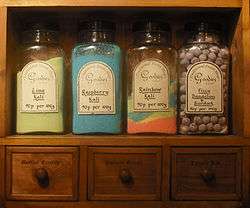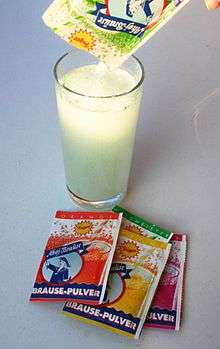Sherbet (powder)
Sherbet is a fizzy powder sweet, usually eaten by dipping a lollipop or liquorice, or licking it on a finger. It is sometimes called kali.[1]
 Jars of colourful sherbet powder in a sweetshop | |
| Alternative names | Soda powder |
|---|---|
| Type | Confectionery |
| Main ingredients | Sugar, flavouring, edible acid and base |
Etymology
The word "sherbet" is from Turkish şerbet, which is from Persian شربت, which in turn comes from "sharbat", Arabic شَرْبَة sharbah, a drink, from "shariba" to drink. Also called "sorbet", which comes from French "sorbet", from Italian "sorbetto" and in turn from Turkish "şerbet". The word is cognate to syrup in English. Historically it was a cool effervescent or iced fruit soft drink. The meaning, spelling and pronunciation have fractured between different countries. It is usually spelled "sherbet", but a common south of England pronunciation, using the intrusive 'r' changes this to "sherbert".
It is not to be confused with the North American "sherbet", which is a variant of the iced dessert sorbet.
History

Beginning with the 19th century sherbet powder (soda powder) became popular.[2] "Put a spoonful of the powder in a cup of water, mix it and drink it as soon as possible, during the time of sparkling. ... Because this way the most of acid of air is lost ... it is more practicable to put the powder into the mouth and flush it with some water."[2] 2 g of sodium bicarbonate and 1.5 g of tartaric acid were separately packed in little coloured paper bags.[2]
Sherbet used to be stirred into various beverages to make effervescing drinks, in a similar way to making lemonade from lemonade powders, before canned carbonated drinks became ubiquitous. Sherbet is now used to mean this powder sold as a sweet. (In the United States, it would be somewhat comparable to the powder in Pixy Stix or Fun Dip, though having the fizzy quality of effervescing candy, such as Pop Rocks.)
Ingredients
Sherbet in the United Kingdom and other Commonwealth countries is a fizzy powder, containing sugar and flavouring, and an edible acid and base. The acid may be tartaric, citric or malic acid, and the base may be sodium bicarbonate, sodium carbonate, magnesium carbonate, or a mixture of these and/or other similar carbonates . To mask the unappetising flavour of the reactive powders, a large amount of sugar is added, as well as icing sugar and fruit or cream soda flavouring.The acid-carbonate reaction occurs upon presence of moisture (juice/saliva), becoming "fizzy".
Products
Sherbet can be sold by itself or used as a decorative agent on other sweets. The measured qualities of sherbet include granularity, colour, "zing" (acidity) and flavouring (normally a citrus fruit).
Sherbet lemon
The sherbet lemon is a popular sweet in the UK, and is included in many sweet shops. It is the main flavour of boiled sweets with powdered sherbet centres – such as sherbet fruits, where sherbet limes, strawberries, blackcurrants, raspberries and orange are popular flavours. The sherbet lemon has a citrus taste and is sour and tangy. The sherbet in the middle explodes, making the sweet suddenly more sour.[3]
In the Harry Potter series, the character, Albus Dumbledore has a particular fondness for sherbet lemons, and the name of the sweet was used as a passphrase to access his office.
Sherbet Fountain

Barratt's "Sherbet Fountain" consists of sherbet and a stick made from liquorice, and has been sold since 1925. The original concept of the Sherbert Fountain was sold to Barratt's by Henry Edward Brunt and was rebranded under their name.
In the traditional paper packaging, the top of the stick was intended to be bitten off to form a straw[4] and the sherbet sucked through it, where it fizzes and dissolves on the tongue. The "new" format only includes a solid liquorice stick, so the sherbet must be licked off that, or eaten directly. This method of consumption was also considered acceptable with the original packaging. This is advertised on the packet as "Sherbet with a liquorice dip".
Fruit flavoured with lollipop
Sherbet dips or Sherbet Dabs are also popular, such as the Dip Dab by Barratt. They consist of a small packet of sherbet, with a lollipop sealed into the bag. Once the lollipop has been licked, it can be dipped into the sherbet and then sucked clean, alternatively it can simply be used to shovel the sherbet into the mouth.
Flying saucers
Invented by the Antwerp-based company Belgica, Flying saucers are small dimpled discs of edible coloured paper (rice paper), typically filled with white unflavoured sherbet (the same form as in Sherbet Fountains). The first flying saucers were produced in the 1950s.[5]
Slang
Sherbet has been used in parts of both the UK and Australia as slang for an alcoholic drink, especially beer. This use is noted in a slang dictionary as early as 1890, and still appears in list of slang terms written today (especially lists of Australian slang). "We're heading to the pub for a few sherbets." – ... pints of beer."[6]
See also
- Sharbat (Middle Eastern drink)
- Italian ice
- Sorbet
- Pixy Stix – a popular brand of dextrose-rich sherbet powder manufactured by The Willy Wonka Candy Company
- Fun Dip - another Wonka powder, in a different format
- Swizzels Matlow – notable manufacturer of sherbet products
References
- "Thoughtco Fizzy Sherbet Powder Candy Recipe". Thoughtco. Retrieved 14 April 2020.
- Brausepulver in Meyers Konversations-Lexikon (1895)
- Slater, Nigel: Eating for England: the delights and curiosities of the British at table, London: Fourth Estate 2007, ISBN 9780007199464, p. 124.
- Simon Bowers (18 January 2008). "Cadbury sells Barratt's Sherbet Fountain firm for £58m". The Guardian. Retrieved 20 May 2013.
- "Zure ouwel". www.streekproduct.be (in Dutch). Retrieved 2 November 2018.
- "Sherbet". dictionary.com. n.d. Retrieved 20 May 2014.
External links
| Look up sherbet in Wiktionary, the free dictionary. |
- Of the Street Sale of Ginger-Beer, Sherbet, Lemonade,&C., from London Labour and the London Poor, Volume 1, Henry Mayhew, 1851; subsequent pages cover the costs and income of street sherbet sellers.
- Tangerine Confectionery homepage
- Instructions to make sherbet